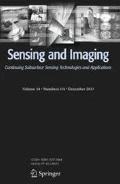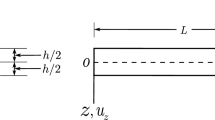Abstract
In this paper, we present a study of the static and dynamic responses of a fixed–fixed and cantilever microbeam (using both the lumped and the distributed models) to a DC and a step DC voltage. A Galerkin-based step by step linearization method and a Galerkin-based reduced order model have been used to solve the governing static and dynamic equations, respectively. The calculated static and dynamic pull-in voltages have been validated by previous experimental and theoretical results and a good agreement has been achieved. The introduction of novel design corrective coefficients, independent of the beam’s material and geometric properties, results in a closed form relationship between static pull-in voltage of the lumped model and static & dynamic pull-in voltages of the distributed models, and takes into account the residual stresses, axial force and damping effects. Multiplying these design coefficients with the static pull-in voltage of the lumped model, the static and dynamic pull-in voltage of a given microbeam can be obtained without the need to solve the nonlinear governing equations.






Similar content being viewed by others
References
Sallese, J. M., Grabinski, W., Meyer, V., Bassin, C., & Fazan, P. (2001). Electrical modeling of a pressure sensor MOSFET. Sensors and Actuators. A, Physical, 94, 53–58.
Nabian, A., Rezazadeh, G., Haddad-derafshi, M., & Tahmasebi, A. (2008). Mechanical behavior of a circular micro plate subjected to uniform hydrostatic and non-uniform electrostatic pressure. Journal of Microsystem Technology, 14, 235–240.
Rezazadeh, G., Khatami, F., & Tahmasebi, A. (2007). Investigation of the torsion and bending effects on static stability of electrostatic torsional micromirrors. Journal of Microsystem Technology, 13, 715–722.
Saif, M. T. A., Alaca, B. E., & Sehitoglu, H. (1999). Analytical modeling of electrostatic membrane actuator micro pumps. Journal of Microelectromechanical Systems, 8, 335–345.
Rezazadeh, G., Tayefe-Rezaei, S., Ghesmati, J., & Tahmasebi, A. (2007). Investigation of the pull-in phenomenon in drug delivery micropump using Galerkin method. Sensors & Transducers Journal, 78, 1098–1107.
Soleymani, P., Sadeghian, H., Tahmasebi, A., & Rezazadeh, G. H. (2006). Pull-in instability investigation of circular micro pump subjected to nonlinear electrostatic force. Sensors & Transducers Journal, 69, 622–628.
Bao, M., & Wang, W. (1996). Future of microelectromechanical systems (MEMS). Sensors and Actuators. A, Physical, 56, 135–141.
Senturia, S. (2001). Microsystem design. Norwell, MA: Kluwer.
Rezazadeh, G. (2007). A comprehensive model to study nonlinear behaviour of multilayered micro beam switches. Microsystem Technologies, 14, 35–141.
Sadeghian, H., Rezazadeh, G. H., & Osterberg P. M. (2007). Application of the generalized differential quadrature method to the study of pull-in phenomena of MEMS switches. Journal of Microelectromechanical Systems, 16(6), 1334–1340.
Osterberg, P. M., & Senturia, S. D. (1997). M-TEST: A test chip for MEMS material property measurement using electrostatically actuated test structures. Journal of Microelectromechanical Systems, 6, 107–118.
Abdel-Rahman, E. M., Younis, M. I., & Nayfeh, A. H. (2002). Characterization of the mechanical behavior of an electrically actuated microbeam. Journal of Micromechanics and Microengineering, 12, 759–766.
Younis, M. I., Abdel-Rahman, E. M., & Nayfeh, A. (2003). A reduced-order model for electrically actuated microbeam-based MEMS. Journal of Microelectromechanical Systems, 12(5), 672–680.
Younis, M. I., Miles, R., & Jordy, D. (2006). Investigation of the response of microstructures under the combined effect of mechanical shock and electrostatic forces. Journal of Micromechanics and Microengineering, 16, 2463–2474.
Thomson, W. T., & Dahleh, M. D. (1998). Theory of vibration with applications. USA: Prentice Hall.
Shigley, J. E. (1986). Mechanical engineering design. USA: McGraw-Hill.
Mukherjee, T., Fedder, G. K., & White, J. (2000). Emerging simulation approaches for micromachined devices. IEEE Transactions on Computer-Aided Design of Integrated Circuits and Systems, 19, 1572–1589.
Senturia, S. D., Aluru, N., & White, J. (1997). Simulating the behavior of MEMS devices. Computing in Science & Engineering, 4, 30–43.
Gupta, R. K. (1997). Electrostatic pull-in test structure design for in situ mechanical property measurement of microelectromechanical systems (MEMS), Ph.D. dissertation, MIT, Cambridge, MA, pp. 10–27.
Nayfeh, A., Younis, M. I., & Abdel-Rahman, E. M. (2005). Reduced-order models for MEMS applications. Journal of Nonlinear Dynamics, 41, 211–236.
Lynch, J. P., Partridge, A., Law, K. H., Kenny, T. W., Kiremidjian, A. S., & Carryer, E. (2003). Design of piezoresistive MEMS-based accelerometer for integration with wireless sensing unit for structural monitoring. Journal of Aerospace Engineering, 16(3), 108–114.
Rezazadeh, G., Tahmasebi, A., & Zubtsov, M. (2006). Application of piezoelectric layers in electrostatic MEM actuators: Controlling of pull-in voltage. Journal of Microsystem Technology, 12, 1163–1170.
Nayfeh, H., & Mook, D. T. (1979). Nonlinear oscillations. Wiley: New York.
Rezazadeh, G., & Tahmasebi, A. (2006). Eliminating of the residual stresses effect in the fixed–fixed end type MEMS switches by piezoelectric layers. Sensors & Transducers Journal, 66, 534–542.
Osterberg P. (1995). Electrostatically actuated microelectromechanical test structures for material property measurement, Ph.D. thesis, MIT, Cambridge.
Hung, E. S., & Senturia, S. D. (1999). Generating efficient dynamical models for microelectromechanical systems from a few finite-element simulation runs. Journal of Microelectromechanical Systems, 8, 280–289.
Ananthasuresh, G. K., Gupta R. K., & Senturia, S. D. (1996) An approach to macromodeling of MEMS for nonlinear dynamic simulation. In Proceeding ASME international conference of mechanical engineering congress and exposition (MEMS), Atlanta, GA, (pp. 401–407).
Krylov,S., & Maimon, R. (2003). Pull-in dynamics of an elastic beam actuated by distributed electrostatic force. In Proceeding 19th biennial conference in mechanical vibration and noise (VIB), Chicago, IL. DETC2003/VIB-48518.
Nayfeh, A., Younis, M. I., & Abdel-Rahman, E. M. (2007). Dynamic pull-in phenomenon in MEMS resonator. Journal of Nonlinear Dynamics, 48, 153–163.
Author information
Authors and Affiliations
Corresponding author
Rights and permissions
About this article
Cite this article
Rezazadeh, G., Fathalilou, M. & Sadeghi, M. Pull-in Voltage of Electrostatically-Actuated Microbeams in Terms of Lumped Model Pull-in Voltage Using Novel Design Corrective Coefficients. Sens Imaging 12, 117–131 (2011). https://doi.org/10.1007/s11220-011-0065-2
Received:
Revised:
Published:
Issue Date:
DOI: https://doi.org/10.1007/s11220-011-0065-2




